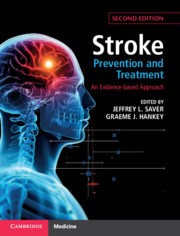Book contents
- Stroke Prevention and Treatment
- Stroke Prevention and Treatment
- Copyright page
- Dedication
- Contents
- Contributors
- Preface
- Part I Foundations
- Part II Systems of Care
- Part III Acute Treatment of Ischaemic Stroke and Transient Ischaemic Attack
- Part IV Acute Treatment of Haemorrhagic Stroke
- Part V Prevention
- Chapter 15 Prevention of Stroke by Lowering Blood Pressure
- Chapter 16 Prevention of Stroke by Lowering Blood Cholesterol Concentrations
- Chapter 17 Prevention of Stroke by Modification of Additional Vascular and Lifestyle Risk Factors
- Chapter 18 Drugs, Devices, and Procedural Therapies to Prevent Recurrent Cardiogenic Embolic Stroke
- Chapter 19 Long-term Antithrombotic Therapy for Large and Small Artery Occlusive Disease
- Chapter 20 Carotid and Vertebral Artery Revascularization
- Chapter 21 Cervical Artery Dissection and Cerebral Vasculitis
- Chapter 22 Prevention of Intracerebral and Subarachnoid Haemorrhage
- Part VI Stroke Rehabilitation and Recovery
- Index
- References
Chapter 16 - Prevention of Stroke by Lowering Blood Cholesterol Concentrations
from Part V - Prevention
Published online by Cambridge University Press: 15 December 2020
- Stroke Prevention and Treatment
- Stroke Prevention and Treatment
- Copyright page
- Dedication
- Contents
- Contributors
- Preface
- Part I Foundations
- Part II Systems of Care
- Part III Acute Treatment of Ischaemic Stroke and Transient Ischaemic Attack
- Part IV Acute Treatment of Haemorrhagic Stroke
- Part V Prevention
- Chapter 15 Prevention of Stroke by Lowering Blood Pressure
- Chapter 16 Prevention of Stroke by Lowering Blood Cholesterol Concentrations
- Chapter 17 Prevention of Stroke by Modification of Additional Vascular and Lifestyle Risk Factors
- Chapter 18 Drugs, Devices, and Procedural Therapies to Prevent Recurrent Cardiogenic Embolic Stroke
- Chapter 19 Long-term Antithrombotic Therapy for Large and Small Artery Occlusive Disease
- Chapter 20 Carotid and Vertebral Artery Revascularization
- Chapter 21 Cervical Artery Dissection and Cerebral Vasculitis
- Chapter 22 Prevention of Intracerebral and Subarachnoid Haemorrhage
- Part VI Stroke Rehabilitation and Recovery
- Index
- References
Summary
Although higher plasma cholesterol concentrations have not been reported to be associated with increased stroke risk, cholesterol lowering has been reported to decrease this risk. This decrease can be achieved with statins, which are well-tolerated, provided they are not given to patients with active liver or muscle diseases. Statin treatment in addition to a healthy lifestyle is recommended for the primary prevention of ischaemic stroke in patients with pre-existing coronary heart disease or other high-risk conditions such as diabetes and hypertension. Statins with intensive lipid-lowering effects are recommended for their positive influence on reducing the risks of stroke and cardiovascular events for patients with prior ischaemic stroke or TIA presumed to be of non-cardioembolic origin, even with an LDL-C level =100 mg/dL, with or without evidence of other clinical atherosclerotic cardiovascular diseases. Despite the good safety profile of statins, further studies are clarify safety in patients with prior cerebral haemorrhage and if they may increase brain haemorrhage to a small degree. PCSK9 inhibitors are advised, as add-on therapy to statins, for patients with a high cardiac risk not able to achieve an optimal LDL-C level, though studies with longer follow-up are needed
Keywords
- Type
- Chapter
- Information
- Stroke Prevention and TreatmentAn Evidence-based Approach, pp. 297 - 307Publisher: Cambridge University PressPrint publication year: 2020



